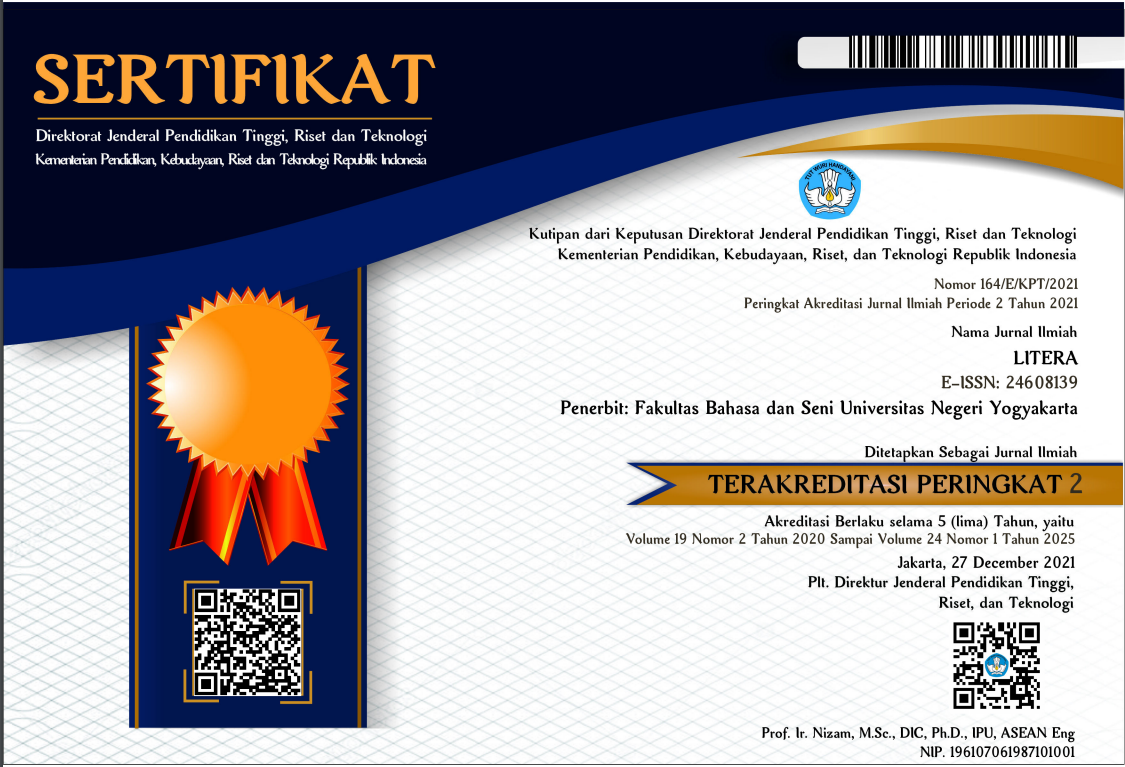INTERSECTING OPPRESSION OF GENDER AND RACE IN TONI MORRISON’S THE BLUEST EYE AND GOD HELP THE CHILD
Abstract
White domination in America can make white ideology of beauty spread and
influence the African-American society. Toni Morrison’s novels, The Bluest Eye and God Help the Child, depict the influence. This study attemps to uncover the intersecting oppression of race and gender in the novels and to explain how African-American women cope with the oppression. This study is descriptive qualitative research. The data sources are Morrison’s novels The Bluest Eyeand God Help the Child. The study has two findings. Firstly, African-American society experiences oppression as an impact of the white beauty hegemony. The most disadvantageous oppression is the internalization of white beauty values. Holding such values makes African-American women feel inferior and hate their own physical characteristics that are far from the white ideal of beauty. Meanwhile, African-American women who have darker skin colors experience the hardest oppression because they also become the victims of oppression committed by some circles of African-American society, which tend to consider them unequal. It reflects the complexity of oppression experienced by African-American women. Secondly,self-consciousness is the main factor of attempts to release them from the oppression. Without self-consciousness, African-American women can be trapped in values that deteriorate their self-pride of identity.
Keywords: intersecting oppression, African-American women, skin color
Keywords
Full Text:
PDFReferences
Ashcroft, B., Griffiths, G., dan Tifflin, H. (1998). Key Concepts in Post-Colonial Studies. New York: Routledge.
Bay, M. (2000). The White Image in the Black Mind: African-American Ideas about White People, 1830-1925. New York: Oxford University Press.
Ciment, J. (2007). Atlas of African- American History. New York: Facts on File, Inc.
Collins, P. H. (2000). Black Feminist Thought. New York: Routledge.
Farrington, D.P. (1993). “Understanding and Preventing Bullying”. Crime and Justice. 17. 381-458. https://www. jstor.org/stable/1147555.
Guerrero, E. (1990). “Tracking “The Look” in the Novels of Toni Morrison”. Black American Literature Forum. 24 (4), 761-773. http://www. jstor.org/stable/3041801.
Henretta, J. A., Brownlee, W.E., Brody, D., Ware, S. (1993). America’s History Vol 2. New York: Worth Publishers.
Hill, M. E. (2002). “Skin Color and the Perception of Attractiveness among African-Americans: Does Gender Make a Diffrence?”. Social Psychology Quarterly. 65 (1), 77-79. http://www. jstor.org/stable/3090169.
Iswalono, S. (2014). “Resistensi dan Respon Etnik Afro-Amerika atas Marjinalisasi Etnik Anglo-Amerika dalam Puisi Karya Hughes”. Litera. 13 (1), 155-168.
Keita, F. (2018). “Conjuring Aesthetic Blackness: Abjection and Trauma in Toni Morrison’s God Help the Child.” Africanology: The Journal of Pan African Studies. 11 (3), 43-55.
Koentjaraningrat. (2014). Pengantar Antropologi I. Jakarta: Rineka Cipta. Long, L. A. (2013). “A New Midwesternism in Toni Morrison’s “The Bluest Eye”. Twentieh Century Literature. 59 (1), 104-125. http:// www.jstor.org/stable/24247112.
Morrison, T. (2004). The Bluest Eye. New York: RosettaBooks LLC.
Morrison, T. (2015). God Help the Child. New York: Vintage Internasional.
Moses, C. (1999). “The Blues Aesthethic in Toni Morrison’s The Bluest Eye”. African American Review. 33 (4), 623-637.
http://www.jstor.org/stable/ 2901343. Patton, T. O. (2006). “Hey Girl, Am I
More than My Hair?: African American Women and Their Struggles with Beauty, Body Image, and Hair”. NWSA Journal. 18 (2),
-51. http://www.jstor.org/stable/4317206.
Raminez, M.L. (2016). ““Childhood Cuts Festered and Never Scabbed Over”: Child Abuse in Toni Morrison’s God Help the Child”. Alicante Journal of English Studies. 29, 145-164.
Ramtani, S. (2015). Childhood Trauma in Toni Morrison’s God Help the Child. Disertation. Bejaia: Abdurrahman Mira University of Bejaia.
Ruth, S. (1988). “Understanding Oppression and Liberation”. An Irish Quarterly Review. 77 (308), 434-444. h t t p s : / / w w w . j s t o r . o r g / stable/30088154.
Synnott, A. (2002). The Body Social: Symbolism, Self and Society. New York: Routledge.
Thompson, V.L.S. (2006). “African American Body Image: Identity and Physical Self Acceptance”. Humbold Journal of Social Relations. 31 (2), 44-67. h t t p : / / w w w . j s t o r . o r g / stable/23263216.
Trisnawati, R.K. (2009). Hegemony of White Beauty Standard in Toni Morrison’s The Bluest Eye. Thesis. Yogyakarta: Universitas Gadjah Mada.
Udasmoro, W. (2015). Apropriasi Gender. Yogyakarta: Prodi Sastra Perancis FIB UGM.
Wallowitz, L. (2008). “Chapter 9: Resisting the White Gaze: Critical Literacy and Toni Morrison’s “The Bluest Eye”” Counterpoints. 326. Critical Literacy as Resistance: Teaching for Social Justice Across the Secondary Curriculum. 151-164. h t t p : / / w w w . j s t o r . o r g / stable/42980110.
Wolf, N. (2004). The Beauty Myth; How Images of Beauty are Used Against Women: Mitos Kecantikan: Kala Kecantikan Menindas Perempuan. (A. Swastika, transl.). Yogyakarta: Niagara. (Original Book, 2002).
DOI: https://doi.org/10.21831/ltr.v18i3.27796
Refbacks
- There are currently no refbacks.
______________________
__________________________________________________________________________________________________
Litera Journal is published by the Faculty of Languages, Arts, and Culture Universitas Negeri Yogyakarta in collaboration with Himpunan Sarjana Kesusasteraan Indonesia (HISKI)
The International Journal of Linguistic, Literature, and Its Teaching at http://http://journal.uny.ac.id/index.php/litera/ is licensed under a Creative Commons Attribution-ShareAlike 4.0 International License
__________________________________________________________________________________________________















